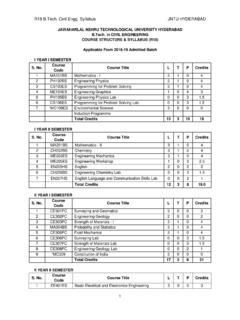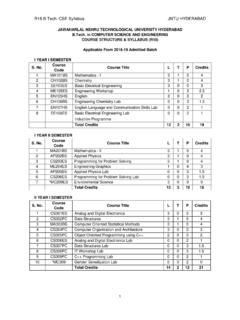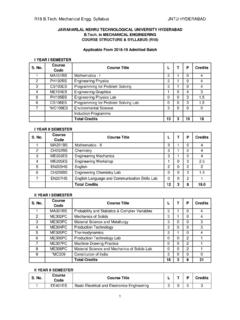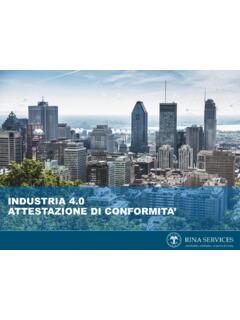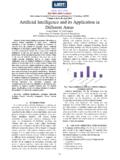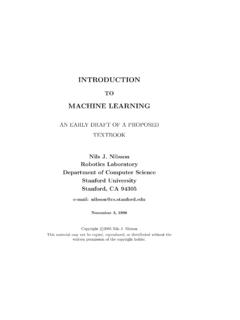Transcription of R18 B.Tech. CSE (AI & ML) Syllabus JNTU HYDERABAD
1 R18 CSE (AI & ML) Syllabus jntu HYDERABAD 1 JAWAHARLAL NEHRU TECHNOLOGICAL UNIVERSITY HYDERABAD in COMPUTER SCIENCE AND ENGINEERING (ARTIFICIAL INTELLIGENCE AND MACHINE LEARNING) II YEAR COURSE STRUCTURE & Syllabus (R18) Applicable From 2020-21 Admitted Batch II YEAR I SEMESTER S. No. Course Code Course Title L T P Credits 1 CS310PC Discrete Mathematics 3 0 0 3 2 CS302PC Data Structures 3 1 0 4 3 MA313BS Mathematical and Statistical Foundations 3 0 0 3 4 CS304PC Computer Organization and Architecture 3 0 0 3 5 CS311PC Python Programming 2 0 0 2 6 SM306MS Business Economics & Financial Analysis 3 0 0 3 7 CS307PC Data Structures Lab 0 0 3 8 CS312PC Python Programming Lab 0 0 3 9 *MC309 Gender Sensitization Lab 0 0 2 0 Total Credits 17 1 8 21 II YEAR II SEMESTER S. No. Course Code Course Title L T P Credits 1 CS416PC Formal Language and Automata Theory 3 0 0 3 2 CS417PC Software Engineering 3 0 0 3 3 CS403PC Operating Systems 3 0 0 3 4 CS404PC Database Management Systems 3 1 0 4 5 CS412PC Object Oriented Programming using Java 3 1 0 4 6 CS406PC Operating Systems Lab 0 0 3 7 CS407PC Database Management Systems Lab 0 0 3 8 CS408PC Java Programming Lab 0 0 2 1 9 *MC409 Constitution of India 3 0 0 0 Total Credits 18 2 8 21 R18 CSE (AI & ML) Syllabus jntu HYDERABAD 2 CS310PC: DISCRETE MATHEMATICS II Year I Sem.
2 L T P C 3 0 0 3 Prerequisites: An understanding of Mathematics in general is sufficient. Course Objectives Introduces the elementary discrete mathematics for computer science and engineering. Topics include formal logic notation, methods of proof, induction, sets, relations, graph theory, permutations and combinations, counting principles; recurrence relations and generating functions. Course Outcomes: Ability to understand and construct precise mathematical proofs Ability to use logic and set theory to formulate precise statements Ability to analyze and solve counting problems on finite and discrete structures Ability to describe and manipulate sequences Ability to apply graph theory in solving computing problems UNIT - I The Foundations: logic and Proofs: Propositional logic , Applications of Propositional logic , Propositional Equivalence, Predicates and Quantifiers, Nested Quantifiers, Rules of Inference, Introduction to Proofs, Proof Methods and Strategy.
3 UNIT - II Basic Structures, Sets, Functions, Sequences, Sums, Matrices and Relations Sets, Functions, Sequences & Summations, Cardinality of Sets and Matrices Relations, Relations and Their Properties, n-ary Relations and Their Applications, Representing Relations, Closures of Relations, Equivalence Relations, Partial Orderings. UNIT - III Algorithms, Induction and Recursion: Algorithms, The Growth of Functions, Complexity of Algorithms Induction and Recursion: Mathematical Induction, Strong Induction and Well-Ordering, Recursive Definitions and Structural Induction, Recursive Algorithms, Program Correctness UNIT - IV Discrete Probability and Advanced Counting Techniques: An Introduction to Discrete Probability, Probability Theory, Bayes Theorem, Expected Value and Variance Advanced Counting Techniques: Recurrence Relations, Solving Linear Recurrence Relations, Divide-and-Conquer Algorithms and Recurrence Relations, Generating Functions, Inclusion-Exclusion, Applications of Inclusion-Exclusion UNIT - V Graphs.
4 Graphs and Graph Models, Graph Terminology and Special Types of Graphs, Representing Graphs and Graph Isomorphism, Connectivity, Euler and Hamilton Paths, Shortest-Path Problems, Planar Graphs, Graph Coloring. Trees: Introduction to Trees, Applications of Trees, Tree Traversal, Spanning Trees, Minimum Spanning Trees TEXT BOOK: 1. Discrete Mathematics and its Applications with Combinatorics and Graph Theory- Kenneth H Rosen, 7th Edition, TMH. R18 CSE (AI & ML) Syllabus jntu HYDERABAD 3 REFERENCE BOOKS: 1. Discrete Mathematical Structures with Applications to Computer Tremblay and R. Manohar, TMH, 2. Discrete Mathematics for Computer Scientists & Mathematicians: Joe L. Mott, Abraham Kandel, Teodore P. Baker, 2nd ed, Pearson Education. 3. Discrete Mathematics- Richard Johnsonbaugh, 7 ThEdn.
5 , Pearson Education. 4. Discrete Mathematics with Graph Theory- Edgar G. Goodaire, Michael M. Parmenter. 5. Discrete and Combinatorial Mathematics - an applied introduction: Grimald, 5th edition, Pearson Education. R18 CSE (AI & ML) Syllabus jntu HYDERABAD 4 CS302PC: DATA STRUCTURES II Year I Sem. L T P C 3 1 0 4 Prerequisites: A course on Programming for Problem Solving . Course Objectives: Exploring basic data structures such as stacks and queues. Introduces a variety of data structures such as hash tables, search trees, tries, heaps, graphs. Introduces sorting and pattern matching algorithms. Course Outcomes: Ability to select the data structures that efficiently model the information in a problem. Ability to assess efficiency trade-offs among different data structure implementations or combinations.
6 Implement and know the application of algorithms for sorting and pattern matching. Design programs using a variety of data structures, including hash tables, binary and general tree structures, search trees, tries, heaps, graphs, and AVL-trees. UNIT - I Introduction to Data Structures, abstract data types, Linear list singly linked list implementation, insertion, deletion and searching operations on linear list, Stacks-Operations, array and linked representations of stacks, stack applications, Queues-operations, array and linked representations. UNIT - II Dictionaries: linear list representation, skip list representation, operations - insertion, deletion and searching. Hash Table Representation: hash functions, collision resolution-separate chaining, open addressing-linear probing, quadratic probing, double hashing, rehashing, extendible hashing.
7 UNIT - III Search Trees: Binary Search Trees, Definition, Implementation, Operations- Searching, Insertion and Deletion, AVL Trees, Definition, Height of an AVL Tree, Operations Insertion, Deletion and Searching, Red Black, Splay Trees. UNIT - IV Graphs: Graph Implementation Methods. Graph Traversal Methods. Sorting: Heap Sort, External Sorting- Model for external sorting, Merge Sort. UNIT - V Pattern Matching and Tries: Pattern matching algorithms-Brute force, the Boyer Moore algorithm, the Knuth-Morris-Pratt algorithm, Standard Tries, Compressed Tries, Suffix tries. TEXT BOOKS: 1. Fundamentals of Data Structures in C, 2nd Edition, E. Horowitz, S. Sahni and Susan Anderson Freed, Universities Press. 2. Data Structures using C A. S. Tanenbaum, Y. Langsam, and Augenstein, PHI/Pearson Education. REFERENCE BOOK: 1.
8 Data Structures: A Pseudocode Approach with C, 2nd Edition, R. F. Gilberg and Forouzan, Cengage Learning. R18 CSE (AI & ML) Syllabus jntu HYDERABAD 5 MA313BS: MATHEMATICAL AND STATISTICAL FOUNDATIONS II Year I Sem. L T P C 3 0 0 3 Prerequisites: Mathematics courses of first year of study. Course Objectives: The Number Theory basic concepts useful for cryptography etc The theory of Probability, and probability distributions of single and multiple random variables The sampling theory and testing of hypothesis and making inferences Stochastic process and Markov chains. Course Outcomes: After learning the contents of this course, the student must be able to Apply the number theory concepts to cryptography domain Apply the concepts of probability and distributions to some case studies Correlate the material of one unit to the material in other units Resolve the potential misconceptions and hazards in each topic of study.
9 UNIT - I Greatest Common Divisors and Prime Factorization: Greatest common divisors, The Euclidean algorithm, The fundamental theorem of arithmetic, Factorization of integers and the Fermat numbers Congruences: Introduction to congruences, Linear congruences, The Chinese remainder theorem, Systems of linear congruences UNIT - II Simple Linear Regression and Correlation: Introduction to Linear Regression, The Simple Linear Regression Model, Least Squares and the Fitted Model, Properties of the Least Squares Estimators, Inferences Concerning the Regression Coefficients, Prediction, Simple Linear Regression Case Study Random Variables and Probability Distributions: Concept of a Random Variable, Discrete Probability Distributions, Continuous Probability Distributions, Statistical Independence. Discrete Probability Distributions: Binomial Distribution, Poisson distribution.
10 UNIT - III Continuous Probability Distributions: Normal Distribution, Areas under the Normal Curve, Applications of the Normal Distribution, Normal Approximation to the Binomial Fundamental Sampling Distributions: Random Sampling, Sampling Distributions, Sampling Distribution of Means and the Central Limit Theorem, Sampling Distribution of S2, t Distribution, F- Distribution. UNIT - IV Estimation & Tests of Hypotheses: Introduction, Statistical Inference, Classical Methods of Estimation. Estimating the Mean, Standard Error of a Point Estimate, Prediction Intervals, Tolerance Limits, Estimating the Variance, Estimating a Proportion for single mean , Difference between Two Means, between Two Proportions for Two Samples and Maximum Likelihood Estimation. UNIT - V Stochastic Processes and Markov Chains: Introduction to Stochastic processes- Markov process.

